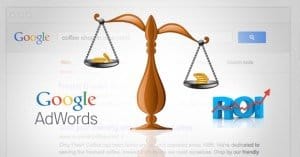What is Considered a Good Pay Per Click ROI?

Pay Per Click advertising should be treated like any other business investment. It’s an initial expense that brings potential customers to your site, where you have to convert them into paying customers. If you fail, the money you spent on their clicks is wasted. If you succeed, a mere $5 invested in PPC can make you hundreds in return.
Measuring your return on investment, and adjusting your plans as you go, is a big part of success with PPC. So, what’s a good ROI for using PPC?
Target ROI
If you want a pithy, virtually meaningless answer, any positive ROI is a good ROI. If you spend $5 and you make one sale for a $6 product, you come out $1 ahead. It’s not a high ROI, but it’s positive, which is still good.
On the other hand, that answer is valueless. How did you calculate that ROI? How does it stack up to other investments your business makes? Running a PPC ad for a mere dollar profit isn’t worth the time, when you can invest those few dollars in something that will make a lot more money.
A large part of ROI comes down to a few things. You need to calculate your ROI correctly, which means understanding what it means in the first place. You also need to set goals; what does a positive ROI look like to you? How much do you need to make before it’s worth the time of running the ad?
Calculating ROI
The textbook definition of ROI is the profit minus the costs, all divided by the costs. This is a good base, but it doesn’t really cover every scenario.
First, consider return on ad spend, or ROAS. ROAS is a way of calculating ROI specifically for PPC and other forms of advertising. This is simplified, because it doesn’t try to calculate your entire business profits and costs into the factor. It’s actually quite easy to calculate. Take your ad budget for PPC for a given time span, calculate how much you made based on the visitors who came in from your PPC ads, and plug both numbers into the formula. If you don’t know how much you made from PPC newcomers in that time, you’ll need to go back to your analytics to measure it.
For example, if you had a profit from your ads of $100, and you ran your PPC for $50, your formula would be (100-50)/50. That works out to be 1, which, when multiplied by 100, is your percentage ROI: 100%. If instead you made $200 in profits from the same ads, 200-50=150, 150/50=3, for 300% ROI.
An actual ROI calculation is a bit more detailed when calculating cost. You have to include factors beyond just the money you invest in the PPC. You also have to calculate the cost of the ad copy and image design, even the time you spend, as employees cost money over time. You should even include the cost of keeping your website online. It’s a lot more work, and essentially requires complete business accounting records.
A third calculation comes when you apply this same amount of specificity to the profit end of the calculation as well as the cost. Some profits are easy and tangible, in the immediate conversions. Some profits are harder to grasp, like the eventual potential profit from leads generated by your PPC. This is typically called the Profit Per Impression model.
Setting Goals
ROAS is generally the best calculation to make for your PPC. You don’t really need to know the overall profits and expenses from your business to calculate full business ROI; after all, those will mostly be the same whether your PPC is active or not.
In order to determine whether you have a sufficient ROAS, you will need to set goals. How much of a return do you want in a given time?
To set a PPC goal, you simply need to make an educated guess as to where you can reasonably boost your profit in a given time. Say you currently make $10,000 per week. You figure you can spend an unknown amount of money on an ad. That ad will have a conversion rate you know, and you obviously know what the average purchase profit is for a conversion. All you need to know is how many clicks on that ad you can reasonably expect to get in a given time. Even this you can find out through basic testing and an ad pilot program.
So with a business making a $10,000 weekly profit, you learn that with 5,000 clicks at a 5% conversion rate you at your average cart price, you can boost that profit to $15,000 per week. Your ROI for the ads would be that extra $5,000, minus by the cost of the 5,000 clicks, then divided by that cost.
This gives you an educated guess as to the profits you can make from running your program. It’s only a guess; the number of clicks might be smaller in that week, the profit might be lower, the conversion rate might differ. It’s all up in the air until you run the ads and see how they perform.
An Acceptable ROI
Once you have a predicted ROI, you can make a judgment call. Is that projection the most you can possibly receive, or the least? Can you adjust that number lower and come up with a number that would be satisfactory? Essentially, you need to use the data you crunched to set a minimum targeted ROI for your PPC ads.
That’s all. A minimum goal gives you a benchmark. You expect to make $5,000 in profits, but you’re aware that with a lower conversion rate and higher than expected click costs, you might only pull in $3,000. That $3,000 becomes your minimum benchmark. Any ROI under it is not acceptable. Any ROI at or above that level becomes a worthwhile ROI.
Thankfully, with PPC, you can adjust your campaigns on the fly. Further, your data is right there to be measured. You can see if your campaign is performing poorly and you can adjust.
- Adjust keyword targets to cheaper – or higher converting – keywords.
- Adjust targeted number of clicks to increase profits or cut losses.
- Adjust ad copy to encourage further conversions.
- Adjust site landing page to boost conversion rate.
All of these are within your control and can be changed and tested on the fly. It makes it much easier to calculate and adjust your ROI expectations and goals.
 ContentPowered.com
ContentPowered.com







